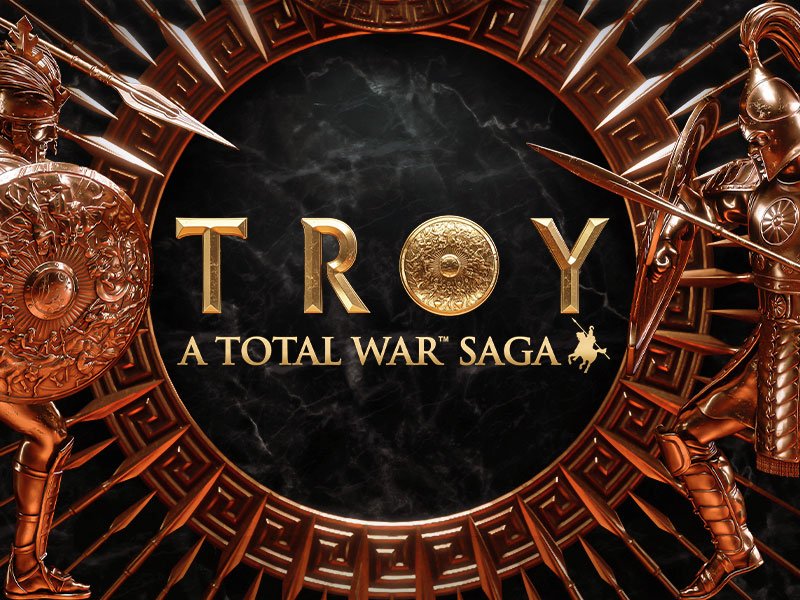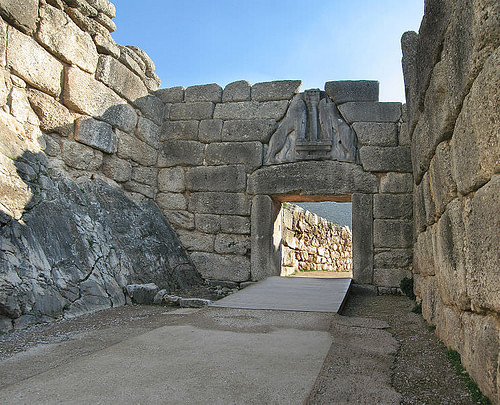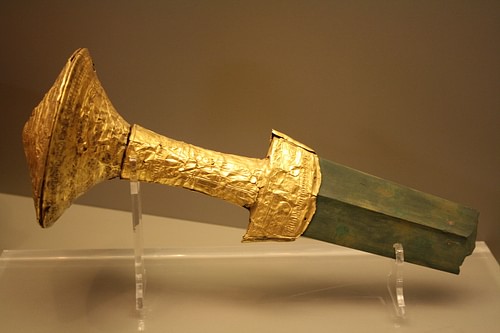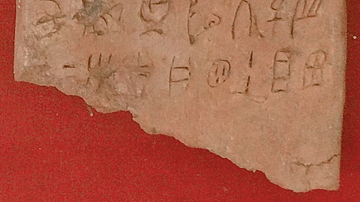
The Mycenaean Civilization flourished in the Late Bronze Age (c. 1700-1100 BCE), peaking from the 15th to the 13th century BCE. The Mycenaeans extended their influence throughout the Peloponnese in Greece and across the Aegean from Crete to the Cycladic islands. They are named after their chief city of Mycenae in the Argolid of the northeast Peloponnese.
The Mycenaeans were influenced by the earlier Minoan civilization (2000-1450 BCE) which had spread from its origins at Knossos, Crete to include the wider Aegean. Architecture, art and religious practices were assimilated and adapted to better express the perhaps more militaristic and austere Mycenaean culture. The Mycenaeans came to dominate most of mainland Greece and several islands, extending trade relations to other Bronze Age cultures in such places as Cyprus, the Levant, and Egypt. The culture made a lasting impression on later Greeks in the Archaic and Classical periods, most tangibly in their myths of Bronze Age heroes like Achilles and Odysseus and their exploits in the Trojan War.
Major Mycenaean Centres
The Mycenaeans were indigenous Greeks who were likely stimulated by their contact with Minoan Crete and other Mediterranean cultures to develop a more sophisticated sociopolitical culture of their own. Major Mycenaean centres included Mycenae (traditional home of Agamemnon), Tiryns (perhaps the oldest centre), Pylos (traditional home of Nestor), Thebes, Midea, Gla, Orchomenos, Argos, Sparta, Nichoria, and probably Athens. In time, the Mycenaeans would even establish themselves on Crete and especially at Knossos, thus superseding the Minoans as the dominant culture in the southern Aegean by the second half of the 15th century BCE.
The largest city (although not a capital city in any sense) was Mycenae, built on an impressive citadel and hill over 278 metres (912 ft.) above sea level where there are remains of large 'palace' buildings and hundreds of tombs and shaft graves, including nine large stone tholos tombs (1600-1300 BCE). Other impressive remains include sections of the fortification walls and the famous Lion Gate (1250 BCE) with its heraldic pair of lions above the entrance.
Beyond trading relations, the exact political relationship between the over 100 Mycenaean centres spread across Greece is not clear. It is not even clear what the relationship was between a single palace and its surrounding population as the former seems to have specialised in the manufacture of luxury goods and the latter in foodstuffs, some of which were then stored in the palace. The political relationship between a palace and its village or between different palaces is not known. Despite this lack of clarity, there were many shared cultural features across sites which makes the term Mycenaean culture a useful one. Such shared features include architecture, frescoes, pottery, jewellery, weaponry, and of course, the Greek language and writing in the form of Linear B (an adaptation of the Minoan Linear A).
Mycenaean Architecture
The Megaron
A large palace complex has been found at many of the Mycenaean centres. These complexes, whilst displaying some site-unique developments, display several important architectural features in common. The complexes were built around a large rectangular central hall or Megaron. The Mycenaean Megaron was the precursor for the later Archaic and Classical temples of the Greek world and consisted of an entrance porch, a vestibule, and the hall itself. This was the heart of the palace and contained a large circular hearth (usually more than 3 m / 9.8 ft. in diameter) with four wooden columns supporting a holed ceiling or light well. It was also the throne room of the ruler or wanax. There is usually a second, smaller hall (often called the 'Queen's Megaron'), many private apartments and additional areas set aside for administration, storage, and manufacturing. Rooms were richly decorated with fresco paintings on the walls and plaster-painted floors. Regarding materials, rooms in the palace were constructed with rubble fill and cross-beamed walls and then covered in plaster inside and limestone blocks outside. Columns and ceilings were usually of painted wood, sometimes with bronze additions.
Cyclopean Walls
The whole palace complex was surrounded by a fortification wall of large unworked blocks (termed Cyclopean as it was believed that only the giant Cyclopes could have moved such massive stones). Such walls could reach 13 metres (42.6 ft.) in height and be as much as 8 metres (26 ft.) thick. They are seen best at Mycenae, Tiryns, and Thebes and are in stark contrast to the unprotected palaces of Minoan Crete.
Corbel galleries - arched corridors created by progressively overlapping stone blocks, circular stone tombs with corbelled roofs, and monumental doorways with massive stone lintels with relieving triangles are also common features of Mycenaean sites. Other Mycenaean architectural structures include terracing of agricultural lands, damns for flood management (particularly evident at Tiryns), and small bridges built from large roughly-hewn stone blocks, again, seemingly the work of the Cyclopes. In contrast to these labour-intensive structures, the non-elite of Mycenaean society lived in modest mud-brick houses which had stone foundations.

Mycenaean Trade
That the Mycenaean civilization had trading contact with other Aegean cultures is evidenced by the presence of foreign goods in Mycenaean settlements such as gold, ivory, copper and glass and by the discovery of Mycenaean goods such as pottery in places as far afield as Egypt, Mesopotamia, the Levant, Anatolia, Sicily, and Cyprus. No doubt perishable goods such as olive oil, perfumed oil, and wine were also significant Mycenaean exports but, unfortunately, the paucity of surviving written records - limited to, for example, only around 70 Linear B clay tablets from a major site like Mycenae, means that more details on interregional trade are at present lacking. The Uluburun shipwreck, a 14th-century BCE vessel discovered off the coast of Turkey, was carrying raw material trade goods such as copper and tin ingots, ivory, and glass disks and was likely on its way to workshops in Mycenaean Greece before it sank.
Mycenaean Art
In art, as expressed in fresco, pottery, and jewellery, the Minoan love of natural forms and flowing design was likewise adopted by the Mycenaean artisans but with a tendency to more schematic and less life-like representation. This new style would become the dominant one throughout the Mediterranean. Geometric designs were popular, as were decorative motifs such as spirals and rosettes. Pottery shapes are much like the Minoan with the notable additions of the goblet and the alabastron (squat jar) with a definite preference for large jars. Terracotta figurines of animals and especially standing female figures were popular, as were small sculptures in ivory, carved stone vessels, and intricate gold jewellery. Frescoes depicted plants, griffins, lions, bull-leaping, battle scenes, warriors, chariots, figure-of-eight shields and boar hunts, a particularly popular Mycenaean activity.

Mycenaean Religion
Little is known for certain regarding Mycenaean religious practices beyond the importance given to animal sacrifice, communal feasting, the pouring of libations and offerings of foodstuffs. The presence of double axe carvings and horns of consecration in art and architecture suggest strong links with the Minoan religion, although these symbols may have been adopted because of their political resonance. Architectural features such as sunken basins and fresco depictions of altars hint that the Megaron may have had a religious function. Many centres also had specific sanctuary sites for worship, usually close to the palace complex. It is clear that burial was an important ritual as evidenced by the presence of monumental tholos tombs, prominent gravesites and the quantity of precious objects which were buried with the dead - golden masks, diadems, jewellery, and ceremonial swords and daggers.
Collapse & Legacy
The reasons for the demise of the Mycenaean civilization, which occurred in stages from c. 1230 BCE to c. 1100 BCE, are much debated. We do know that several sites were destroyed between 1250 and 1200 BCE, ushering in the so-called Post-Palatial period when the centralised system of palace control declined. There is evidence of a different degree of destruction across sites, and some places escaped the chaos altogether. Some sites were then reinhabited but sometimes seemingly on a smaller scale and with less wealth than previously, while other sites actually became larger and more prosperous than ever. By around 1100 BCE, however, most Mycenaean sites had been reduced to mere villages.
Suggestions from scholars to explain the general collapse of the Mycenaean culture (and other contemporary ones in the Mediterranean) include natural disaster (earthquakes, volcanic explosions, and tsunami), overpopulation, internal social and political unrest, invasion from foreign tribes such as the Sea Peoples, regional climate change or a combination of some or all of these factors. With the mysterious end of the Mycenaean civilization and the so-called Bronze Age Collapse in the ancient Aegean and wider Mediterranean, there came the 'Dark Ages' (another extreme label for a period which was perhaps not as dark as all that) and, although some sites began to revive from the 10th century BCE, it would take several more centuries before Greek culture would finally regain the heights of the Late Bronze Age.
The Mycenaean civilization would so inspire the later Archaic and Classical Greeks from the 8th century BCE onwards that the Bronze Age period came to be seen as a golden one when people respected the gods, warriors were braver and life was generally less complicated and more decent. Legendary names like Agamemnon, Menelaus, Achilles and Odysseus - all Mycenaean Greeks - would be given immortal life in sculpture, on painted pottery and epic literature such as Homer's Iliad which told the story of the great Trojan War, very possibly a myth based on a real conflict or series of conflicts between the Mycenaeans and Hittites.








